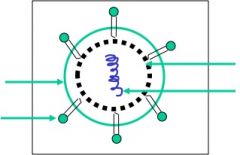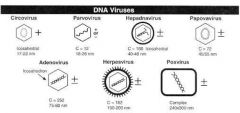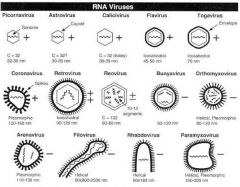![]()
![]()
![]()
Use LEFT and RIGHT arrow keys to navigate between flashcards;
Use UP and DOWN arrow keys to flip the card;
H to show hint;
A reads text to speech;
22 Cards in this Set
- Front
- Back
|
Define virion.
What 3 parts make it up? |
morphologically complete virus particle, which is infectious
The icosahedron structure containing the genetic materials. 1. Genome: ss/ds DNA or RNA (but never both). 2. Capsid : The capsid, or core, is a protein shell surrounding the genome subunits called capsomeres. 3. Envelope: it is derived from host cell membranes by a process called budding. (some don't have the envelope) |
|
|
What comprises the virion genome?
|
ss/ds DNA or RNA (but never both).
|
|
|
What makes up the basic structure of a virus?
|

Envelope, glycoprotein, capsid, genome
|
|
|
What type genome does the virus have?
What are the major proteins encoded by the viral genome? |
-ss/ds DNA/RNA
-structural to make capsids and other virion components. Nonstructural like enzymes involved in nucleic acid replication, transcription, translation, and in shutdown of host cell function, glycoproteins, envelope lipids |
|
|
exon v intron
|
exon - coding region
intron - noncoding region |
|
|
What is specifically interesting about capping mature RNA and replication?
|
Some viruses need to steal the capping genes from the host because it codes for RNA (?). If we can control this, we can potentially control some virusal replications.
|
|
|
Why do we care about genes in virology?
|
The virus is very small and has limited genetic materials.
Some of them has only 2 or 3 genes. Understanding the gene function of the virus is the key to understand the pathogenesis of viruses. The genetic information of the virus is the key for viral disease diagnosis. |
|
|
define a viral envelope
|
Envelope: an outer lipoprotein bilayer membrane.
|
|
|
why icosahedral?
|
from book:
it is the optimum solution to the problem of constructing, from repeating subunits, a strong structure enclosing a maximum volume. from class: Viral genome encodes a few identical capsid subunits It must be packed in symmetrically capsid to provide each with an identical environment Therefore, icosahedral symmetry is preferred in virus structure |
|
|
What are the five basic structural forms of virions?
What are examples of each? |

1 Naked icosahedral: adenoviruses and picornaviruses
2 Naked helical: tobacco mosaic virus 3 Enveloped icosahedral: togaviruses and flaviviruses 4 Enveloped helical: rhabdoviruses and paramyxoviruses 5 Complex: poxviruses |
|
|
What are the 7 DNA viruses?
|

see pic
|
|
|
erase
|

erase
|
|
|
What are the three functions of the viral capsid?
|
Protection of the genome
Stable, protective protein shell Providing recognition and packaging of the nucleic acid genome Delivery of the genome Transmission of specific signals that induce uncoating of the genome Induction of fusion with host cell membrane Other interactions with the host Specific binding of receptor of the host cell Interaction with the host cellular components for transport to intracelluar sites of assembly Interact with the host immune system |
|
|
As viruses don't grow on media, other than filtering, before the TEM was invented, how were viruses categorized?
|
The disease they cause: e.g. hepatitis viruses
Their transmission route: Enteric viruses, acquired by ingestion. Respiratory viruses, acquired by inhalation. Arboviruses, transmitted by arthropods. Rodent-associated viruses. |
|
|
What are the criteria for ICTV classification?
|
Host:
Vertebrates Invertebrate Plants Fungi Protozoa Bacteria Morphology: Size Shape Enveloped Non-enveloped Genome: RNA DNA Single strand Double strand Positive sense Negative sense Replication: Nucleus Cytoplasm Self-encoded polymerase Cellular polymerase Cell-cycle |
|
|
How many genome types do viruses have?
|
7
dsDNA viruses ssDNA viruses dsRNA viruses (+)-sense ssRNA viruses (-)-sense ssRNA viruses RNA reverse transcribing viruses DNA reverse transcribing viruses |
|
|
Define a genetic family and subfamily.
|
Family: A family is a group of genera sharing close phylogenetic relationship
Subfamily: only used for viruses with complexed inter-relationship in a family |
|
|
Define a genus/species
|
A genus is a group of species sharing certain common characters
A virus species is defined as a polythetic class of viruses that constitutes a replicating lineage and occupies a particular ecological niche |
|
|
What does virus family mean?
|
Similar phylogenetics
|
|
|
What is the Baltimore classification?
|
viruses are divided into the following seven classes:
1 dsDNA viruses 2 ssDNA viruses 3 dsRNA viruses 4 (+)-sense ssRNA viruses 5 (-)-sense ssRNA viruses 6 RNA reverse transcribing viruses 7 DNA reverse transcribing viruses |
|
|
What is (+)-Sense vs (-)-Sense?
|
Positive-sense (= plus strand, message strand) RNA: the strand that contains the coding triplets that are translated by ribosomes.
Positive-sense DNA: the strand that contains the same base sequence as the mRNA. Negative sense (= minus strand) RNA or DNA: the strand with base sequence complementary to the mRNA or positive-sense strand. |
|
|
How many proteins are needed to make a virus capsid which have three proteins on each face?
|
Total No. of capsomer =10X(T-1)+12
T = the number of unit triangles on each of the 20 faces of the icosahedron 42 |

